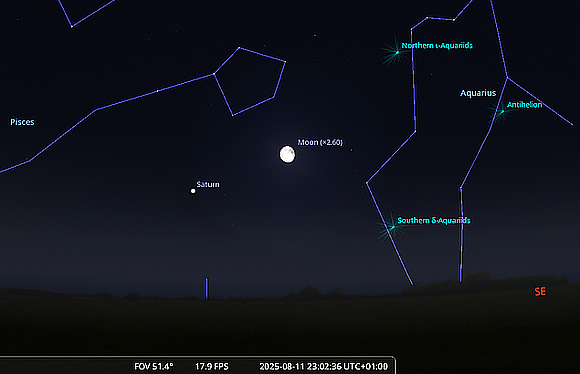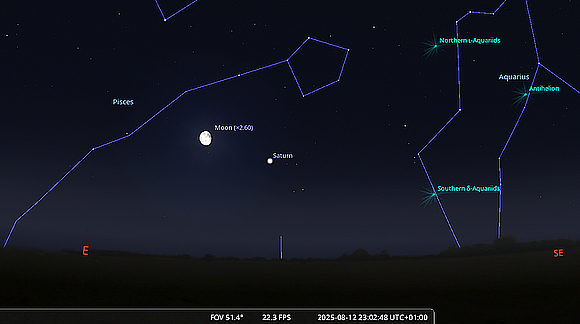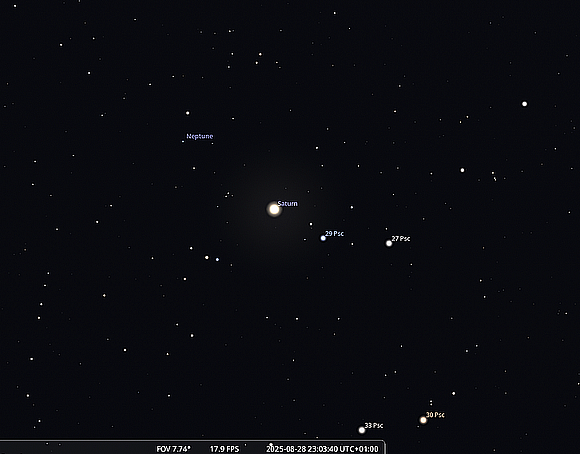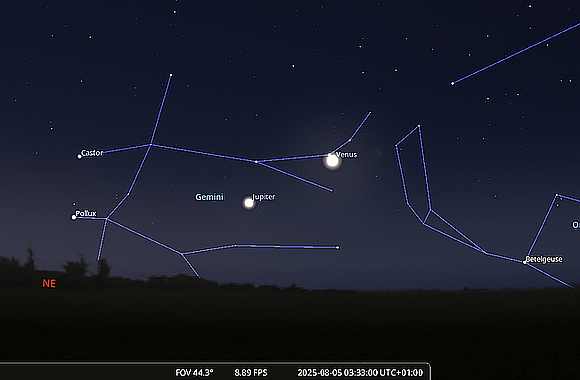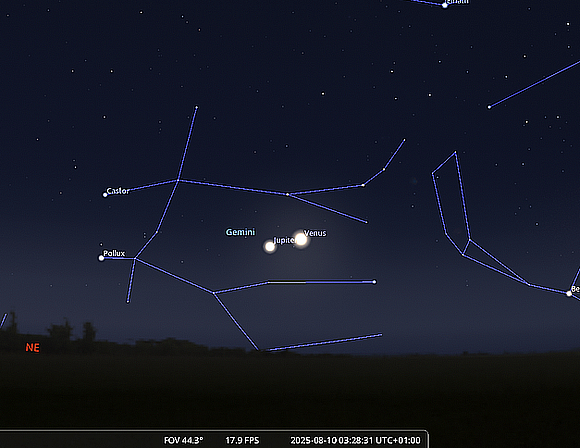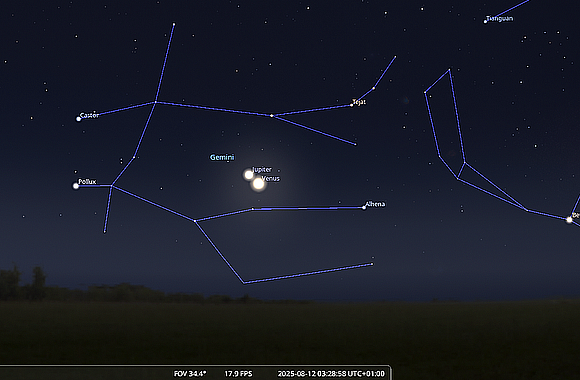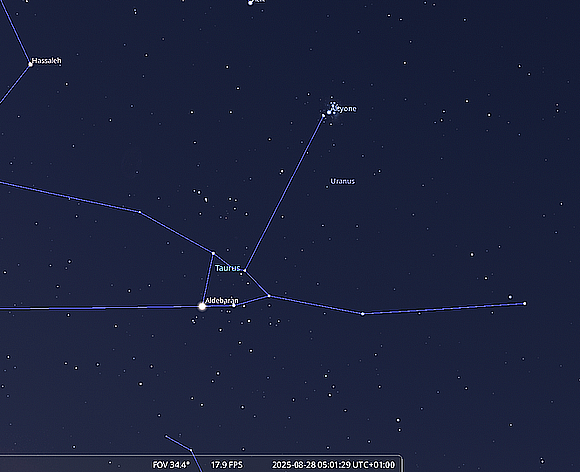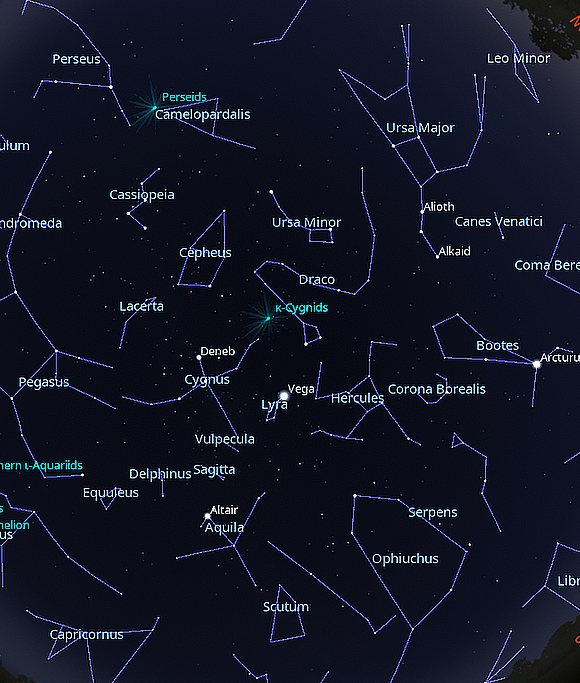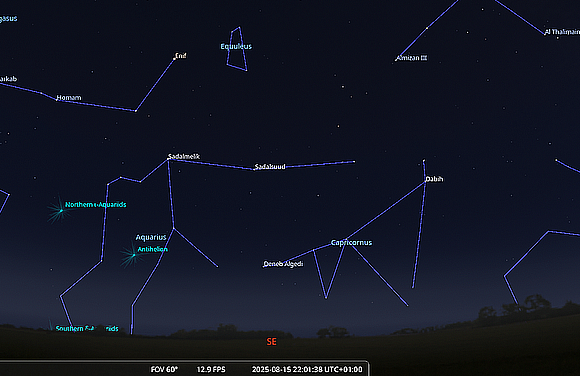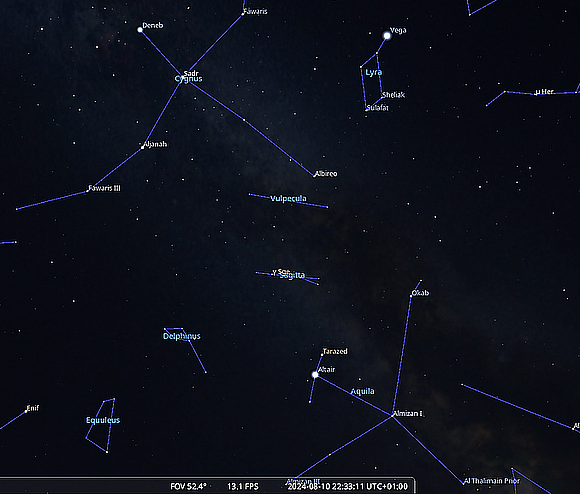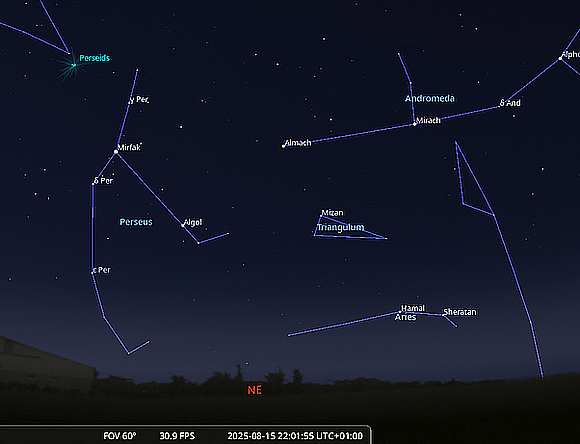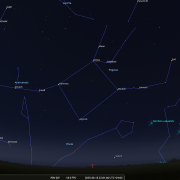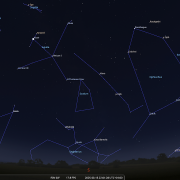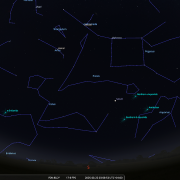In this month's Sky Notes:
Planetary Skylights: A Brief Guide to the August Night Sky
After several months with little planetary action, either in the evening or morning sky, August sees a marked improvement with Saturn starting to make inroads into the evening sky (Neptune is just over a degree above it). Mercury has a fine morning apparition after mid-month, but the highlight is the stunning early morning planetary conjunction of Venus and a returning Jupiter shortly before mid-month.
 Saturn is the first of the naked eye planets to rise, doing so shortly after 23:00hrs at the start of August and 21:00hrs by the end. Currently at magnitude +0.63 Saturn appears conspicuous against the backdrop of the less conspicuous zodiac constellations it is passing through. Presently located below the faint loop of stars marking the western fish in Pisces, Saturn gradually edges back to the Pisces/Aquarius border of the course of the month. For several weeks to come Saturn continues to culminate post-midnight, reaching 32 degrees above the south horizon in the early morning hour. This is still 3 degrees below the celestial equator, not crossing that unseen boundary until March 2026.
Saturn is the first of the naked eye planets to rise, doing so shortly after 23:00hrs at the start of August and 21:00hrs by the end. Currently at magnitude +0.63 Saturn appears conspicuous against the backdrop of the less conspicuous zodiac constellations it is passing through. Presently located below the faint loop of stars marking the western fish in Pisces, Saturn gradually edges back to the Pisces/Aquarius border of the course of the month. For several weeks to come Saturn continues to culminate post-midnight, reaching 32 degrees above the south horizon in the early morning hour. This is still 3 degrees below the celestial equator, not crossing that unseen boundary until March 2026.
Those expecting to view the glorious ring system may be slightly disappointed that the orientation is around 2 degrees only, this year being a ring plane crossing event. The ring system will become edge-on again in November. Under good seeing conditions (post-midnight) a 100mm (4") telescope will reveal the rings, but little to no structure.
Saturn has many moons, most of which are tiny, but a clutch of 'decent sized' satellites including Rhea, Dione and Tethys, are apparent as specks of light especially during ring plane crossing years. Saturn’s largest moon by far, Titan, is visible in the humblest of instruments as a brighter speck in the vicinity of Saturn. The waning gibbous Moon pays Saturn a visit on Aug 11th & 12th.
 Neptune is conveniently placed just over a degree above Saturn. At magnitude +7.8 the outermost recognised planet may be glimpsed with binoculars; however, a telescope is required to make out the tiny blue/grey disk just 2.8 arc-seconds in diameter. A 100mm (4") instrument should be sufficient to show this although instruments above 150mm (6”) will reveal Neptune more satisfactory.
Neptune is conveniently placed just over a degree above Saturn. At magnitude +7.8 the outermost recognised planet may be glimpsed with binoculars; however, a telescope is required to make out the tiny blue/grey disk just 2.8 arc-seconds in diameter. A 100mm (4") instrument should be sufficient to show this although instruments above 150mm (6”) will reveal Neptune more satisfactory.
 Located in the dawn sky, Venus - the 'morning star' remains a conspicuous object low in the east, visible by 4am. It is not the best of morning apparitions for observers situated at mid-northern latitudes; the window of visibility is little more than two hours with Venus not straying too far from the horizon before skies brighten. Despite this, at almost magnitude -4.0, Venus is bright enough to cut through dawn twilight for a brief duration allowing it to be sighted higher in the east.
Located in the dawn sky, Venus - the 'morning star' remains a conspicuous object low in the east, visible by 4am. It is not the best of morning apparitions for observers situated at mid-northern latitudes; the window of visibility is little more than two hours with Venus not straying too far from the horizon before skies brighten. Despite this, at almost magnitude -4.0, Venus is bright enough to cut through dawn twilight for a brief duration allowing it to be sighted higher in the east.
Observations through a telescope will reveal little detail except a phase which will increase from 75% to 84% by the months end.
Venus is involved in the planetary highlight of the month, if not the summer when it moves into conjunction with Jupiter early in August. The downside of this meeting is that it all occurs in the early morning hours which will require an alarm call for most observers wishing to view the conjunction.
Those able to follow the conjunction should do so from Aug 5th onwards for the next 10 days or so. By the 10th the pair are just over 2 degrees apart which reduces to less than a degree on the 12th, their closest separation - Venus sliding below Jupiter. Short focal length telescopes fitted with higher mm eyepieces (32mm, 40mm, or above) i.e. low power, will show both planets in same field of view. It is interesting to note that at mag -3.9 Venus is the brighter with Jupiter at mag - 1.9, yet it is Jupiter which exhibits the larger disc size, 33 arc-seconds compared to Venus’s 13 arc-seconds even though Venus is currently 185 million km distant whereas Jupiter is 890 million km!
On Aug 19th, 20th & 21st a waning crescent Moon passes down by Jupiter, Venus & on to Mercury. View around 04:30hrs if you can.
` Jupiter steadily improves in the pre-dawn sky ending the month reasonably high above the east horizon as dawn breaks. Jupiter will however still be rising 90 minutes the wrong side of midnight even by the start of September. As already mentioned, Jupiter is involved in a superb conjunction with Venus shortly before mid-month, the two planets close together in the dawn sky for several mornings centred on the 12th. Although conspicuous at magnitude -1.9, Jupiter will appear be out matched by Venus at mag -3.9.
Jupiter steadily improves in the pre-dawn sky ending the month reasonably high above the east horizon as dawn breaks. Jupiter will however still be rising 90 minutes the wrong side of midnight even by the start of September. As already mentioned, Jupiter is involved in a superb conjunction with Venus shortly before mid-month, the two planets close together in the dawn sky for several mornings centred on the 12th. Although conspicuous at magnitude -1.9, Jupiter will appear be out matched by Venus at mag -3.9.
Through the eyepiece Jupiter is always a fine sight, the noticeably oblate disk presently 35 arc- seconds in diameter offering up detail and phenomena accessible to very modest instruments.
Look for the darker atmospheric banding across the disc, the great red spot (GRS) and attendant Galilean moons. The GRS is observable in instruments of 114mm (4 1/2") apertures and above when turned in Earth's direction but is not the storm feature it was 30 years ago, having reduced in size by almost 40% in that period. The daily dance of the four Galilean Moons is fascinating to watch, an ever changing 'mini solar system', throwing up a different configuration each night.
 Uranus is located several degrees below the Pleiades star cluster visible in the early morning hours around 02:00hrs mid-month. At mag +5.7 Uranus is technically visible to the naked eye from a dark location and with use of a star chart or sky app. Binoculars will show it as a speck, but apertures of 80mm plus (3"+) are required to reveal the tiny 3.7 arc-second grey-green disk. Instruments above 125mm (5") will define it more clearly.
Uranus is located several degrees below the Pleiades star cluster visible in the early morning hours around 02:00hrs mid-month. At mag +5.7 Uranus is technically visible to the naked eye from a dark location and with use of a star chart or sky app. Binoculars will show it as a speck, but apertures of 80mm plus (3"+) are required to reveal the tiny 3.7 arc-second grey-green disk. Instruments above 125mm (5") will define it more clearly.
General location chart for Uranus - late August early morning sky - 01:30hrs.
(Click for full image)
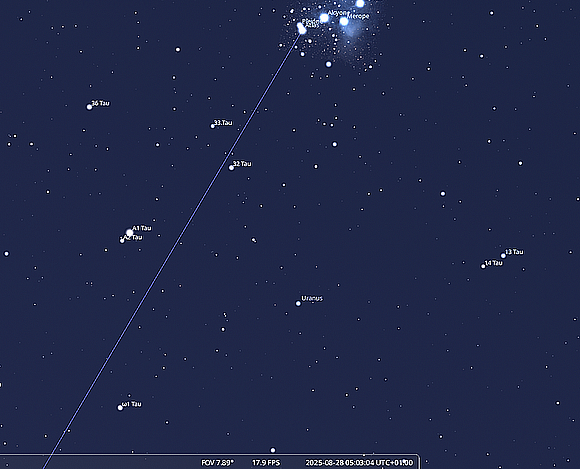 Detailed location chart for Uranus - late August early morning sky - 03:00hrs.
Detailed location chart for Uranus - late August early morning sky - 03:00hrs.
(Click for full image)
 Mercury commences its most favourable early morning apparition for UK observers this year from mid-August. You will need to view 35-45 minutes before sunrise looking to the east with a flat horizon. Start scanning 5 degrees above the E-NE horizon from the 15th (shortly before 05:00hrs) At mag +1.5 Mercury will be visible in binoculars, but as Mercury brightens over the next 5 days it should become visible to the naked eye.
Mercury commences its most favourable early morning apparition for UK observers this year from mid-August. You will need to view 35-45 minutes before sunrise looking to the east with a flat horizon. Start scanning 5 degrees above the E-NE horizon from the 15th (shortly before 05:00hrs) At mag +1.5 Mercury will be visible in binoculars, but as Mercury brightens over the next 5 days it should become visible to the naked eye.
Mercury pulls out to greatest elongation from the Sun on the 19th - to 19 degrees. It will then have increased in height to almost 9 degrees above the horizon by 05:15hrs. Brightness will also increase to magnitude +0.7. Mercury will reside a similar height for the next few days after the 19th before slowly dropping back down, continuing to brighten as it does so, reaching magnitude -0.3 by the end of the month.
An observing challenge! Mercury and very slender crescent Moon - Aug 22nd @ 04:30hrs.
(Click for larger image)
Pointing a telescope toward Mercury will reveal little except a phase, the planet is small and 'seeing' is nearly always marginal, so any detail on the surface will be difficult to resolve. At the start of the apparition the disk is 26% increasing to 76% (gibbous) by the start of September. Good hunting.
August Meteors - The Perseids
Meteor activity is rather low during summer, with one, glorious exception; the Perseids, one of the more prolific meteor showers and without doubt the most widely observed by the public. The Perseids are active from just after mid-July until into the fourth week of August with activity highest from Aug 8th-15th. The shower normally reaches a peak overnight of Aug 11-12th or 12-13th.
Sometimes known as "The tears of St. Lawrence"; the martyred Christian deacon whose feast day falls on Aug 10th, just before the Perseids peak, these particular ‘tears’, like most meteor showers, are composed of debris deposited over many thousands of years by periodic comets.
Perseids are associated with the periodic comet Swift Tuttle which has an orbital period of around 133 years. It appeared last in 1992 when enhanced rates were seen, the next pass being in 2126 when the comet could be as bright as Comet Hale-Bopp was back in 1997, providing that predictions are correct of course!
It is widely perceived amongst the public that meteors are quite substantial in size, but this is not so, Perseid meteoroids are not dissimilar in size and density to that of instant coffee granules with the occasional pea or marble sized fragment. Every August, Earth encounters various strands of the Swift-Tuttle debris stream giving rise to the eagerly anticipated shooting stars.
Penetrating the upper atmosphere some 60 (100km) miles up, Perseid 'meteoroids' reach speeds of 43miles/second, interacting with atoms as they push through the air, a process known as ablation, before becoming ionised and releasing a packet of light. It is this brief luminous flash we call a meteor. Particularly bright examples often leave behind persistent ionisation trails in their wake, the classic shooting star.
The radiant of the shower: the location in the sky from which the meteors appear to emanate, lies within the constellation of Perseus, which in August is rising in the northeast during the evening and best placed in the pre-dawn sky. For 2025 the actual UK shower peak is predicted to be around 21:00hrs on Aug 12th when Earth passes into the densest part of the comet Swift Tuttle debris dust stream. Enhanced activity for a period of around 16 hours centred on this peak is then most likely, more so when the radiant is located high in the sky.
I would suggest the probable optimum dates this year are the early morning hours of Aug 12th (Tuesday) and the 13th (Wednesday), but if you can, check out the 11th as well. Under ideal conditions the zenith hourly rate (ZHR) for the Perseids is typically 80-120, but actual observed rates by one person are around 40% of this.
Under ideal conditions observers up before dawn on a peak date (say around 02-03:00hrs) would expect to witness 30 - 50 meteors per hour, whereas late evening (post 22:00hrs) observers would likely spot only 10 -15 per hour.
Now here's the big 'but'. Observing conditions are far from ideal this year, with a large waning gibbous Moon illuminating the sky until dawn breaks - drowning out all but the brightest Perseids. A similar scenario exists right across the peak period - talk about bad timing! Do not give up altogether though, brighter examples and fireballs will still be visible, so patience will eventually be rewarded.
Anyone intending to observe for lengthy periods on the 10/11th, 11/12th or 12/13th should observe areas of the sky a good hand span away from Perseus and between 40-70 degrees above the horizon. Fingers crossed, wrap up warm and hopefully you'll wish upon a few 'Tears'.
August Night Sky 2025
August sees the resumption of astronomical twilight; the deepest level of twilight or true darkness absent since May. It will be the second half of the month before this change becomes noticeably apparant allowing observers more time to explore deep sky objects.
At the start of August, the brightest stars still don't emerge until 22:00hrs, Arcturus in the west and Vega overhead the first to do so. Within ten minutes Altair (midway up in the south, Deneb (high to the east) and completing this initial clutch of stellar luminaries, Capella low to the north, all become visible. Antares may just be glimpsed low to SW if the observer’s horizon is flat and seeing good.
By 22:30hrs many of the fainter stars visible to the naked eye complete the celestial jigsaw puzzle, making constellation recognition that much easier. You can then locate the familiar saucepan outline of the ‘Plough’ (part of Ursa Major, the Great Bear) high in the NW, the arc of its handle pointing down in the direction of conspicuous Arcturus in Boötes the Herdsman. Note the delicate starry circlet of Corona Borealis - the Northern Crown, its chief star Alphecca, the centre stone of this celestial tiara situated upper left of Arcturus. The recurrent nova star T-Cor B should become visible just below and left of the crown when it finally erupts. (see last month’s notes).
Much of the SW aspect is occupied by just two constellations, the sprawling figures of Hercules and Ophiuchus. Hercules occupies the region higher in the SW and is best identified by the ‘keystone’ asterism. Below Hercules extending down toward the WSW horizon is the huge, indistinct outline of Ophiuchus, the serpent bearer. As twilight deepens in this direction you may spy the orange hue of Antares in Scorpius just above the SW horizon.
Due south, standing on the horizon is the large asterism known as the ‘Teapot’, the visible portion of Sagittarius seen from the UK. It may be traced if skies are transparent. Located in this direction, on the border between these two constellations amidst the celebrated star clouds of the Milky Way, lies the centre of our galaxy 27,000 light years away.
Yet more zodiac constellations fill the SE and E horizons, the ecliptic being low to the horizon at this time of year. These include Capricornus - the Sea Goat (SSE), Aquarius - the Water Bearer (ESE) and Pisces - the Fish (E). None are particularly easy to trace from light polluted skies, or when strong moonlight is present. Choose a dark location to view these groups satisfactory. The bright 'star' visible low in the SE later in the month is Saturn highlighting the southern reaches of Pisces.
The asterism known as the ‘summer triangle’ rides high overhead in August. Comprised of brilliant steely blue Vega in the small lozenge shaped pattern of Lyra, Deneb, chief star in the cruciform outline of Cygnus and Altair in Aquila, the most southerly member, this stellar triangle will remain on show well after the summer months have turned to autumn ones.
Look for the two small but distinctive patterns of Sagitta and Delphinus adjacent to the Deneb/Altair side of the triangle. Sagitta is comprised of just 5 stars and according to one legend is associated with Cupid’s arrow. The close-knit group of Delphinus does (with a little imagination) resemble the outline of a dolphin leaping out of water. Bizarrely the group is also known as ‘Jobs coffin’. Two more obscure constellations, Vulpecula and Equuleus also lie in this region of the sky. Vulpecula is home to the fine planetary nebula M27 - the Dumbbell nebula, whilst Lyra hosts the Ring Nebula, M57, both visible in smaller telescopes.
Facing north, Polaris, the pole star in Ursa Minor, can be found by using the pointer stars in the ‘bowl’ of the Plough. The zenith is occupied by the head of Draco, whose body winds between Ursa Major and Ursa Minor. Perseus appears above the NNE horizon, while the “W” pattern of Cassiopeia is located above his right shoulder, with King Cepheus positioned further above. Andromeda, the princess, is lower right, identified by a chain of stars extending toward Pegasus, located in the mid-eastern sky. Within Andromeda's boundaries, the Andromeda Galaxy can be observed on clear, moonless nights; it is the most distant object visible to the naked eye at approximately 2.65 million light years away.
Below Andromeda sit two small constellations - Triangulum, in which M33 - the other pinwheel galaxy, one of the 'big three' galaxies in the local group along with the Andromeda galaxy and our Milky Way. Below Triangulum lie the crooked line of stars marking Aries. Not far to the east, charging over the horizon is Taurus, the exquisite open cluster of the Pleiades marking the bull's tail, the sight of which reminds astronomers that a change of season is in the offing, autumn lies in readiness!
Apologies - the more in depth look at Sagittarius planned for this month is not ready yet. But it will appear next month as an In Focus article.
August Sky Charts
Additional Image Credits:
- Planets and Comets where not otherwise mentioned: NASA
- Sky Charts: Stellarium Software and Starry Night Pro Plus 8
- Log in to post comments


